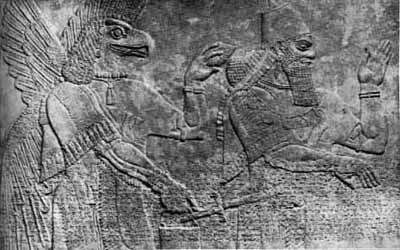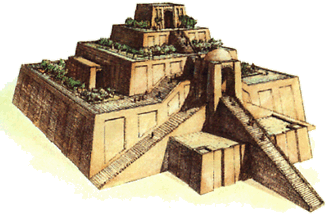


Sumerian Gods - Anunnaki
Mythology
There was no organized set of gods in Sumer - each city-state having its own patrons, temples, and priest-kings. The Sumerians were probably the first to write down their beliefs, which were the inspiration for much of later Mesopotamian mythology, religion, and astrology.
Sumerians believed that the universe consisted of a flat disk enclosed by a tin dome. The Sumerian afterlife involved a descent into a gloomy netherworld to spend eternity in a wretched existence as a Gidim (ghost).

Ziggurats (Sumerian temples) consisted of a forecourt, with a central pond for purification. The temple itself had a central nave with aisles along either side. Flanking the aisles would be rooms for the priests. At one end would stand the podium and a mudbrick table for animal and vegetable sacrifices. Granaries and storehouses were usually located near the temples. After a time the Sumerians began to place the temples on top of multi-layered square constructions built as a series of rising terraces, giving rise to the Ziggurat style.
The religion of the ancient Sumerians has left its mark on the entire Middle East. Not only are its temples and ziggurats scattered about the region, but the literature, cosmogony and rituals influenced their neighbors to such an extent that we can see echoes of Sumer in the Judeo-Christian-Islamic tradition today. From these ancient temples, and to a greater extent, through cuneiform writings of hymns, myths, lamentations, and incantations, archaeologists and mythographers afford the modern reader a glimpse into the religious world of the Sumerians.
Each city housed a temple that was the seat of a major god in the Sumerian pantheon, as the gods controlled the powerful forces that often dictated a human's fate. The city leaders had a duty to please the town's patron deity, not only for the good will of that god or goddess, but also for the good will of the other deities in the council of gods. The priesthood initially held this role, and even after secular kings ascended to power, the clergy still held great authority through the interpretation of omens and dreams. Many of the secular kings claimed divine right; Sargon of Agade, for example claimed to have been chosen by Ishtar/Inanna.
The rectangular central shrine of the temple, known as a 'cella,' had a brick altar or offering table in front of a statue of the temple's deity. The cella was lined on its long ends by many rooms for priests and priestesses. These mud-brick buildings were decorated with cone geometrical mosaics, and the occasional fresco with human and animal figures. These temple complexes eventually evolved into towering ziggurats.
Priests, priestesses, musicians, singers, castrates and hierodules staffed the temple. Various public rituals, food sacrifices, and libations took place there on a daily basis. There were monthly feasts and annual, New Year celebrations. During the later, the king would be married to Inanna as the resurrected fertility god Dumuzi, whose exploits are dealt with below.
When it came to more private matters, a Sumerian remained devout. Although the gods preferred justice and mercy, they had also created evil and misfortune. A Sumerian had little that he could do about it. Judging from Lamentation records, the best one could do in times of duress would be to "plead, lament and wail, tearfully confessing his sins and failings." Their family god or city god might intervene on their behalf, but that would not necessarily happen. After all, man was created as a broken, labor saving, tool for the use of the gods and at the end of everyone's life, lay the underworld, a generally dreary place.
Religion was the central organizing principle of the city-states, each city belonging to a different deity who was worshipped in a large temple. Families also had their own special gods or goddesses, and people prayed by clasping their hands in front of their chests.
The temple was built on top of the ruins of the previous temple until in Uruk the temple of Anu, the god of heaven, rose fifty feet above the plain. Eventually these temples became man-made mountains, like the ziqqurats of Ur, Uruk, Eridu, and Nippur. About a third of the land was owned by the temple which employed many people; some of their land was loaned out at interest or leased for a seventh or eighth of the harvest.
A ruler was called a lord (en) and was often deified. Each city had a governor (ensi) or a king (lugal meaning literally "great man") who lived in a great house (egal), and they often had religious duties as well, particularly to build and maintain temples. The wife of the king was called a lady or queen (nin), and she might take on important projects such as managing the affairs of a temple goddess.